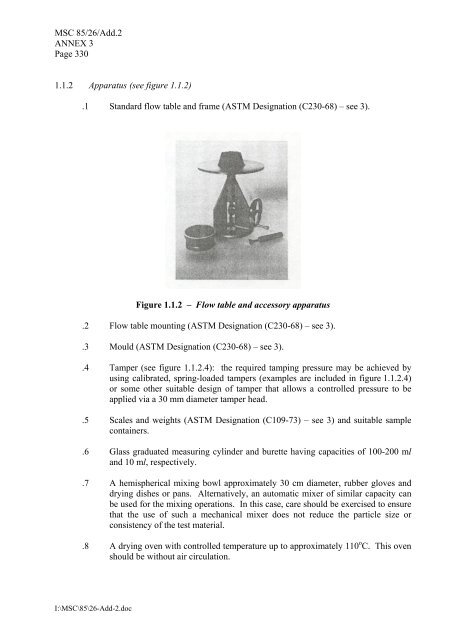MSC 85/26/Add.2 ANNEX 3 RESOLUTION MSC.268(85) - US Coast ...
MSC 85/26/Add.2 ANNEX 3 RESOLUTION MSC.268(85) - US Coast ... MSC 85/26/Add.2 ANNEX 3 RESOLUTION MSC.268(85) - US Coast ...
MSC 85/26/Add.2ANNEX 3Page 3301.1.2 Apparatus (see figure 1.1.2).1 Standard flow table and frame (ASTM Designation (C230-68) – see 3).Figure 1.1.2 – Flow table and accessory apparatus.2 Flow table mounting (ASTM Designation (C230-68) – see 3)..3 Mould (ASTM Designation (C230-68) – see 3)..4 Tamper (see figure 1.1.2.4): the required tamping pressure may be achieved byusing calibrated, spring-loaded tampers (examples are included in figure 1.1.2.4)or some other suitable design of tamper that allows a controlled pressure to beapplied via a 30 mm diameter tamper head..5 Scales and weights (ASTM Designation (C109-73) – see 3) and suitable samplecontainers..6 Glass graduated measuring cylinder and burette having capacities of 100-200 mland 10 ml, respectively..7 A hemispherical mixing bowl approximately 30 cm diameter, rubber gloves anddrying dishes or pans. Alternatively, an automatic mixer of similar capacity canbe used for the mixing operations. In this case, care should be exercised to ensurethat the use of such a mechanical mixer does not reduce the particle size orconsistency of the test material..8 A drying oven with controlled temperature up to approximately 110 o C. This ovenshould be without air circulation.I:\MSC\85\26-Add-2.doc
MSC 85/26/Add.2ANNEX 3Page 3311.1.3 Temperature and humidityFigure 1.1.2.4 – Examples of spring-loaded tampersIt is preferable to work in a room where the samples will be protected from excessivetemperatures, air currents and humidity variations. All phases of the material preparation andtesting procedure should be accomplished in a reasonable space of time to minimize moisturelosses and, in any event, within the day of commencement. Where possible, sample containersshould be covered with plastic film or other suitable cover.1.1.4 ProcedureThe quantity of material required for a flow moisture test will vary according to the specificgravity of the material to be tested. It will range from approximately 2 kg for coal to 3 kg formineral concentrates. It should be collected as a representative sample of the cargo beingshipped. Experience has shown that more accurate test results will be obtained by ensuring thatthe moisture content of the test sample is increased rather than decreased towards the FMP.I:\MSC\85\26-Add-2.doc
- Page 280 and 281: MSC 85/26/Add.2ANNEX 3Page 280CHARA
- Page 282 and 283: MSC 85/26/Add.2ANNEX 3Page 282SEED
- Page 284 and 285: MSC 85/26/Add.2ANNEX 3Page 284permi
- Page 286 and 287: MSC 85/26/Add.2ANNEX 3Page 286CHARA
- Page 288 and 289: MSC 85/26/Add.2ANNEX 3Page 288SEED
- Page 290 and 291: MSC 85/26/Add.2ANNEX 3Page 290SILIC
- Page 292 and 293: MSC 85/26/Add.2ANNEX 3Page 292DISCH
- Page 294 and 295: MSC 85/26/Add.2ANNEX 3Page 294SODIU
- Page 296 and 297: MSC 85/26/Add.2ANNEX 3Page 296SODIU
- Page 298 and 299: MSC 85/26/Add.2ANNEX 3Page 298STAIN
- Page 300 and 301: MSC 85/26/Add.2ANNEX 3Page 300SUGAR
- Page 302 and 303: MSC 85/26/Add.2ANNEX 3Page 302SULPH
- Page 304 and 305: MSC 85/26/Add.2ANNEX 3Page 304SULPH
- Page 306 and 307: MSC 85/26/Add.2ANNEX 3Page 306SUPER
- Page 308 and 309: MSC 85/26/Add.2ANNEX 3Page 308TACON
- Page 310 and 311: MSC 85/26/Add.2ANNEX 3Page 310TANKA
- Page 312 and 313: MSC 85/26/Add.2ANNEX 3Page 312TAPIO
- Page 314 and 315: MSC 85/26/Add.2ANNEX 3Page 314VANAD
- Page 316 and 317: MSC 85/26/Add.2ANNEX 3Page 316VERMI
- Page 318 and 319: MSC 85/26/Add.2ANNEX 3Page 318WOODC
- Page 320 and 321: MSC 85/26/Add.2ANNEX 3Page 320WOOD
- Page 322 and 323: MSC 85/26/Add.2ANNEX 3Page 322EMERG
- Page 324 and 325: MSC 85/26/Add.2ANNEX 3Page 324DISCH
- Page 326 and 327: MSC 85/26/Add.2ANNEX 3Page 326CARRI
- Page 328 and 329: MSC 85/26/Add.2ANNEX 3Page 328VENTI
- Page 332 and 333: MSC 85/26/Add.2ANNEX 3Page 332Conse
- Page 334 and 335: MSC 85/26/Add.2ANNEX 3Page 334I:\MS
- Page 336 and 337: MSC 85/26/Add.2ANNEX 3Page 336Figur
- Page 338 and 339: MSC 85/26/Add.2ANNEX 3Page 338Peat
- Page 340 and 341: MSC 85/26/Add.2ANNEX 3Page 3401.2.3
- Page 342 and 343: MSC 85/26/Add.2ANNEX 3Page 342Figur
- Page 344 and 345: MSC 85/26/Add.2ANNEX 3Page 344Figur
- Page 346 and 347: MSC 85/26/Add.2ANNEX 3Page 346Figur
- Page 348 and 349: MSC 85/26/Add.2ANNEX 3Page 3481.3 P
- Page 350 and 351: MSC 85/26/Add.2ANNEX 3Page 350.2 De
- Page 352 and 353: MSC 85/26/Add.2ANNEX 3Page 3522 Tes
- Page 354 and 355: MSC 85/26/Add.2ANNEX 3Page 3542.1.5
- Page 356 and 357: MSC 85/26/Add.2ANNEX 3Page 356and a
- Page 358 and 359: MSC 85/26/Add.2ANNEX 3Page 3583.1.2
- Page 360 and 361: MSC 85/26/Add.2ANNEX 3Page 3604 Tro
- Page 362 and 363: MSC 85/26/Add.2ANNEX 3Page 3624.2.2
- Page 364 and 365: MSC 85/26/Add.2ANNEX 3Page 364the t
- Page 366 and 367: MSC 85/26/Add.2ANNEX 3Page 36612345
- Page 368 and 369: MSC 85/26/Add.2ANNEX 3Page 368APPEN
- Page 370 and 371: MSC 85/26/Add.2ANNEX 3Page 370MATER
- Page 372 and 373: MSC 85/26/Add.2ANNEX 3Page 372MATER
- Page 374 and 375: MSC 85/26/Add.2ANNEX 3Page 374MATER
- Page 376: MSC 85/26/Add.2ANNEX 3Page 376MATER
<strong>MSC</strong> <strong>85</strong>/<strong>26</strong>/<strong>Add.2</strong><strong>ANNEX</strong> 3Page 3301.1.2 Apparatus (see figure 1.1.2).1 Standard flow table and frame (ASTM Designation (C230-68) – see 3).Figure 1.1.2 – Flow table and accessory apparatus.2 Flow table mounting (ASTM Designation (C230-68) – see 3)..3 Mould (ASTM Designation (C230-68) – see 3)..4 Tamper (see figure 1.1.2.4): the required tamping pressure may be achieved byusing calibrated, spring-loaded tampers (examples are included in figure 1.1.2.4)or some other suitable design of tamper that allows a controlled pressure to beapplied via a 30 mm diameter tamper head..5 Scales and weights (ASTM Designation (C109-73) – see 3) and suitable samplecontainers..6 Glass graduated measuring cylinder and burette having capacities of 100-200 mland 10 ml, respectively..7 A hemispherical mixing bowl approximately 30 cm diameter, rubber gloves anddrying dishes or pans. Alternatively, an automatic mixer of similar capacity canbe used for the mixing operations. In this case, care should be exercised to ensurethat the use of such a mechanical mixer does not reduce the particle size orconsistency of the test material..8 A drying oven with controlled temperature up to approximately 110 o C. This ovenshould be without air circulation.I:\<strong>MSC</strong>\<strong>85</strong>\<strong>26</strong>-Add-2.doc



